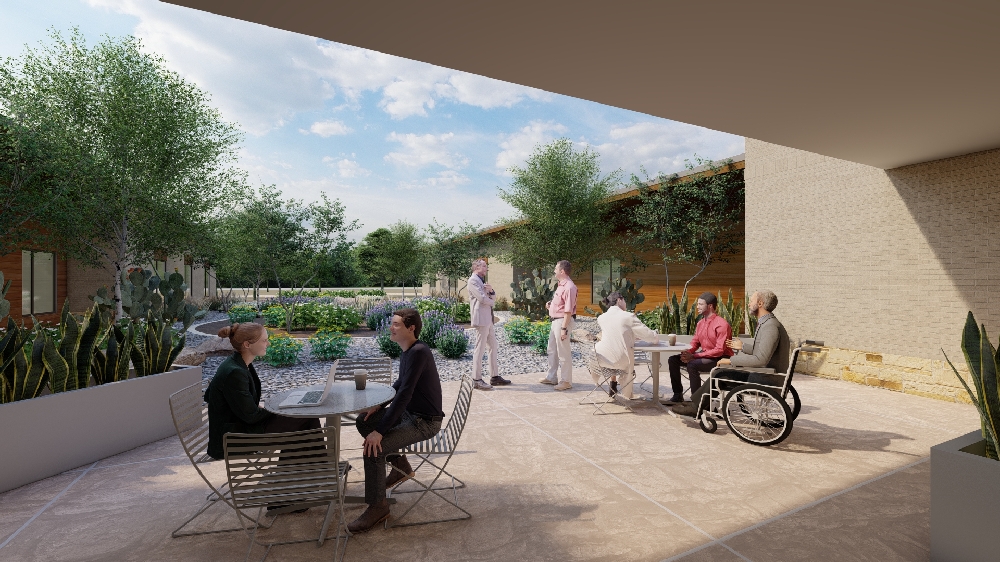According to the Bureau of Labor Statistics, the need for behavioral health is not slowing down anytime soon — projecting it will grow 22% by 2031. At the same time, healthcare systems are realizing the importance of design to address aging facilities and ensure that the next generation of behavioral health facilities prioritizes the well-being and comfort of patients, staff and the community — reducing stigma and prioritizing comfort for those who need it most.
The following are trending design considerations for behavioral health patient populations:
Adolescent and pediatric patients: When it comes to adolescent and pediatric patients, designing for different ability levels is crucial. Care for children exists on a spectrum, just as it does with adults. Providing activities for more acute and autonomous patients is vital in their treatment and care. This can be done by incorporating inclusive features, such as accessible musical instruments and sensory panels, which allow for freedom of play and a pleasant exercise in creativity.
Adult and geriatric patients: Adult and geriatric patients also need a balance of calm respite and activity space. Where you have independent play areas in the younger units, modern spaces in adult and geriatric units may have a small nook for reading, observing art in the landscape or an intentional view into the adjacent landscape. The addition of playful colors to surface materials (e.g., stained, or patterned concrete, poured-in-place rubber) or site furniture also helps enhance and activate the space. Exploring these material combinations, in collaboration with interior designers, can aid in wayfinding and bring a sense of whimsy without creating triggers or negative thoughts.
Specific design interventions for behavioral health staff
As the need for staff increases, tailored amenities contributing to reduced staff stress and absenteeism are becoming essential. The latest amenity trends include:
Adaptable site furniture: Gone are the hard, cold chairs one would expect to find in a behavioral health facility. Loungers in the sun and dining tables with moveable chairs give staff the options to have different experiences — to either be alone or socialize. In the staff-designated spaces, furnishings should be resilient, while delivering comfort and healing to those providing care.
Staff respite areas: Outdoor courtyards throughout the design of modern behavioral health centers should be designated for staff use only. These staff courtyards differ from patient courtyards and usually include a program of small dining and seating areas, elongated and uninterrupted views of nature and a mix of textures (both hardscape and softscape).
Lighting: Artificial light brightens dark spaces and ensures safety for staff and patients. Having adequate light is also vital for face recognition throughout these centers. Soft lighting in exterior staff spaces provides security while allowing for views of the night sky, minimizing light bleed into patient areas.
No live plant material indoors: Mental health professionals are busy caring for people, which is why the interior staff areas should be intentionally free of live plants, resulting in an inside area that is maintenance-free and maintainable in the short and long term for the client. Although it’s encouraged to refrain from living plants indoors, it’s also vital to work closely with architectural design partners to make sure the indoor clinical spaces take as many advantages as possible to connect to outdoor green spaces.
Landscape architecture design and planning can also help to de-institutionalize behavioral health facilities and encourage visitors and community members to use them. When behavioral health centers are designed with consideration for those who visit, they can become a resource for the community and act as a makerspace for all.
Specific design interventions for the community
Community events: When designed with aesthetics in mind, modern behavioral health centers can serve as a space for events. Such is the case for Permian Basin Behavioral Health Center, a unique project in West Texas. Community group rooms located within medical office buildings like PBBHC can open to an outdoor patio or event lawns to provide an alternative programmable space. These outdoor spaces allow for flexible-sized group events without feeling restricted, disturbing other facility functions or confining anyone to the limits of other intended-use interior rooms.
Outdoor areas and community spaces: In community outdoor areas, more traditional furniture pieces, planting and fence materials may be included — so that these spaces can be used not just by outpatient providers, but by the broader community through nonprofits, support groups or higher education groups. Design considerations include furniture types (e.g., moveable, lightweight, flexible use), durable finishes and exterior considerations for shade.
The face of healthcare is changing — for the better. Through Evidence-Based Design, tailored amenities transform even the starkest of spaces and create a feeling of support for all who enter. Thanks in part to thoughtful planning and an eye for detail, the design features, plantings and artistic elements featured in modern behavioral health settings go far beyond pure aesthetics to provide something even more important — a reminder to those within them that with proper care they, too can bloom.
Rendering courtesy of Dunaway




